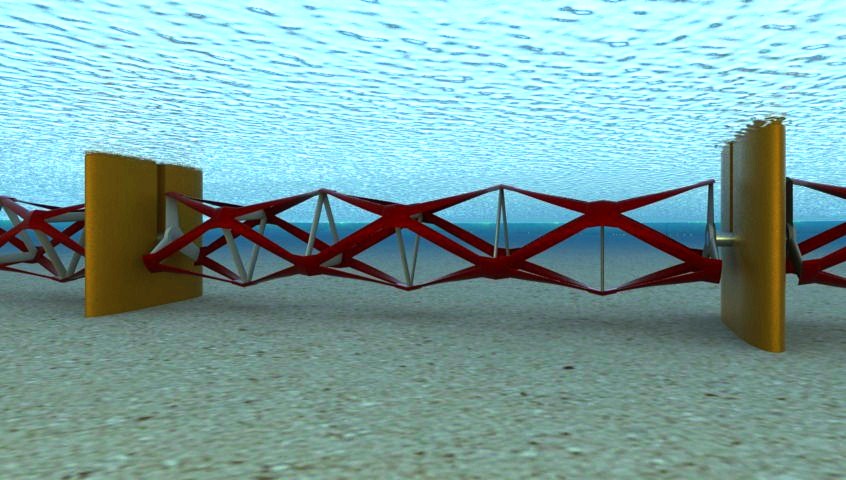Oxford University Engineering
Department has developed an innovative, second generation tidal turbine
(THAWT). Testing has successfully
demonstrated potential effectiveness significantly higher than existing axial
flow designs.

The Kepler Transverse
Horizontal Axis Water Turbine (THAWT) is designed to be operated either in arrays or in stand-alone form. It is
highly effective and efficient in terms of extracting the maximum power from given stretches
of tidal or river current. Theoretical analysis and modelling, confirmed by testing, has
shown outputs more than 50% higher than those achievable by propeller type
turbines placed in the same site. This advantage arises from the greater
rectangular swept area of a THAWT rotor compared with the depth limited
circular swept areas of multiple propeller type rotors. Theoretical analysis
has shown that, because of the free water surface in tidal turbine flows, tidal
turbines, unlike wind turbines, are not subject to the Betz power limit. Greater
powers can be extracted from tidal flows by optimising the blockage ratio
(swept area of turbine divided by flow area). The THAWT rotor design is better
suited to this optimisation than conventional propeller type turbines.
The structure itself is
novel, the blades themselves being configured so that the turbine (called a triangulated stressed truss) needs no enveloping supporting structure (patent pending,
WO/2008/145991). This leads to lower parasitic drag, and hence low power losses
and simple, cheap construction with longer rotors across the flow. This is in contrast to all other transverse horizontal axis turbines on the market, which are limited in their power output by their lack of structural rigidity and consequent limited maximum size
The basic
generating unit comprises two turbines with a central direct drive generator,
with only four supporting bearings and three foundation supports required. As a
consequence of this design, the weight of the unit will be significantly lower
than that achievable by propeller type units. The design philosophy throughout
is focused on extreme reliability combined with ease of installation and maintenance with minimal or no ecological impact.
The illustration shows one possible configuration, a 3 rotor THAWT turbine
assembly. The transverse horizontal axis configuration works equally well with
flow from either direction and hence requires no adjustments as the tide
changes direction.
The turbine is scalable to
suit different marine sites. A typical
turbine rotor would be 10 m diameter and 60 m long sited in a tidal flow with a
mean depth of 20 m. Documented flume tests on a scale model have shown that the
basic 10m diameter, 125 m long unit (two turbines with one generator) should
generate more than 4.4 MW at a water velocity of 2m/sec, and more than 5.3 MW
at a water velocity of 2.5m/sec. In addition, the unit will operate with
reasonable efficiency at low water velocities.
The simplicity of the design
– only one rotating unit, with no gears, and no complex pitch changing mechanisms
– means that the Kepler turbine arrays will have very significantly lower
life-cycle costs than those of first generation machines. |
| |
|
|


